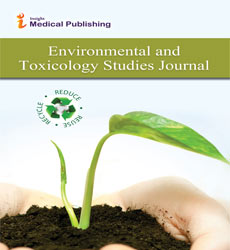Toxicological Impact of Microplastics on Marine Food Chains and Human Health Through Bioaccumulation
Fulvio Albert*
Department of Earth and Environmental Sciences, University of Waterloo, ON N2L 3G1, Canada
*Corresponding author:
Fulvio Albert,
Department of Earth and Environmental Sciences, University of Waterloo, ON N2L 3G1, Canada,
E-mail: fulvio@albert.ca
Received date: February 01, 2025, Manuscript No. ipetsj-25-20613; Editor assigned date: February 03, 2025, PreQC No. ipetsj-25-20613 (PQ); Reviewed date: February 15, 2025, QC No. ipetsj-25-20613; Revised date: February 22, 2025, Manuscript No. ipetsj-25-20613 (R); Published date: February 28, 2025, DOI: 10.36648/.9.1.5
Citation: Albert F (2025) Toxicological Impact of Micro plastics on Marine Food Chains and Human Health through Bioaccumulation. Environ Toxicol J Vol.9 No.1:5
Introduction
Micro plastics, defined as plastic particles smaller than 5 mm, have emerged as pervasive contaminants in marine ecosystems, posing significant ecological and human health concerns. Their small size facilitates ingestion by a wide range of marine organisms, from plankton to top predators, enabling accumulation and transfer throughout the food chain. Beyond physical impacts, micro plastics often adsorb chemical pollutants, including persistent organic pollutants and heavy metals, further increasing their toxicity. Understanding the mechanisms of micro plastic bioaccumulation and the subsequent implications for human exposure is critical for assessing environmental risks and developing mitigation strategies [1].
Description
Micro plastics enter marine food chains primarily through ingestion by lower trophic organisms such as zooplankton, small fish, and mollusks. Once ingested, they can cause physical damage, inflammation, and impaired feeding or reproduction, affecting growth and survival rates. Their persistence in tissues allows for trophic transfer, meaning that predators accumulate micro plastics from prey, leading to higher concentrations in top predators, including commercially important fish and seafood species consumed by humans. This bioaccumulation underscores the ecological significance of micro plastics beyond individual organismal toxicity [2].
Chemical contaminants associated with micro plastics exacerbate toxic effects in marine organisms. Adsorbed pollutants, such as polychlorinated biphenyls (PCBs), polycyclic aromatic hydrocarbons (PAHs), and heavy metals, can desorb within the digestive tract, leading to oxidative stress, endocrine disruption, and nontoxicity Micro plastics in seafood can harm human health Long-term risks include hormone and metabolic disorders tiny particles can cross biological barriers They might accumulate in human tissues. Clear knowledge is needed for safety guidelines 3].
Experimental studies indicate that micro plastics can also act as vectors for pathogenic microorganisms, increasing disease susceptibility in marine populations. These combined effects contribute to altered population dynamics, decreased biodiversity, and disrupted ecosystem functioning. Human health risks arise primarily through dietary exposure to contaminated seafood Human exposure to micro plastics mainly occurs through seafood consumption, where contaminated fish and shellfish introduce plastic particles and toxic chemicals into the body [4].
Regular consumption of fish and shellfish containing micro plastics and associated chemicals may increase the risk of gastrointestinal irritation, systemic inflammation, and long-term chronic effects such as endocrine disruption and metabolic disorders. Moreover, emerging evidence suggests that micro- and Nano plastics may cross biological barriers, raising concerns about cellular-level toxicity and the potential for bioaccumulation in human tissues. Understanding these pathways is essential for informing public health guidelines, seafood safety standards, and environmental policies [5].
Conclusion
The toxicological impact of micro plastics on marine food chains and human health is increasingly evident through bioaccumulation and chemical vectoring. Micro plastics compromise organismal health, disrupt ecosystem stability, and serve as a conduit for pollutant exposure to humans. Addressing this emerging threat requires integrated strategies encompassing pollution reduction, improved waste management, monitoring of seafood, and further research into the mechanisms of micro plastic toxicity and human health implications. Proactive interventions are essential to protect both marine ecosystems and the health of populations reliant on seafood resources.
Acknowledgement
None.
Conflict of Interest
None.
References
- Birrer SC, Dafforn KA, Simpson SL, Kelaher BP, Potts J, et al. (2018) Interactive Effects of Multiple Stressors Revealed by Sequencing Total (DNA) and Active (RNA) Components of Experimental Sediment Microbial Communities. Sci Total Environ 637: 1383–1394
Google Scholar Cross Ref Indexed at
- Laroche O, Pochon X, Tremblay LA, Ellis JI, Lear G, et al. (2018) Incorporating Molecular-Based Functional and Co-Occurrence Network Properties into Benthic Marine Impact Assessments. FEMS Microbiol Ecol 94: fiy167
Google Scholar Cross Ref Indexed at
- Brockmeier EK, Hodges G, Hutchinson TH, Butler E, Hecker M, et al. (2017) The role of omics in the application of adverse outcome pathways for chemical risk assessment. Toxicol Sci 158: 252–262
Google Scholar Cross Ref Indexed at
- Gatzidou ET, Zira AN, Theocharis SE (2007) Toxicogenomics: a pivotal piece in the puzzle of toxicological research. J Appl Toxicol 27: 302–309
Google Scholar Cross Ref Indexed at
- Wang P, Ng QX, Zhang B, Wei Z, Hassan M, et al. (2019) Employing multi-omics to elucidate the hormetic response against oxidative stress exerted by nC60 on Daphnia pulex. Environ Pollut 251: 22–29
Google Scholar Cross Ref Indexed at
Open Access Journals
- Aquaculture & Veterinary Science
- Chemistry & Chemical Sciences
- Clinical Sciences
- Engineering
- General Science
- Genetics & Molecular Biology
- Health Care & Nursing
- Immunology & Microbiology
- Materials Science
- Mathematics & Physics
- Medical Sciences
- Neurology & Psychiatry
- Oncology & Cancer Science
- Pharmaceutical Sciences
